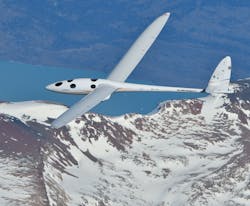Perlan and Trig – the Appliance of Science
The Perlan 2 is a record-breaking high-altitude glider, which has pioneered aeronautical science and produced various scientific discoveries. Trig is supporting Perlan, enabling multiple flights in the upper atmosphere since the original first flight in 2015.
The objective is to achieve flight above 90,000 feet. The team have already broken existing high- altitude records with their highest altitude of 76,124 feet. On each mission the multi-disciplinary ground team rely upon Perlan’s Trig radio and Trig transponder, used to communicate and track every phase of flight.
Perlan chief pilot, Jim Payne said, “Trig equipment has been essential to our success. We are hoping to return to Argentina in 2021 to attempt to reach the 90,000-foot design limit of the Perlan. All of our flights are gathering useful data about the interaction of the southern Polar Vortex and the stratosphere. The project is providing a wealth of data to climate scientists.” Morgan Sandercock, chief engineer and pilot, said “The team at Trig has been extremely diligent and responsive to all of our needs.”
Trig’s compact TT22 transponder and TY91 VHF radio are small, but their contribution is vital. Jim shared, “Weight is a critical factor, we have to consider every ounce to be able to soar to extreme altitudes. Our minimal avionics fit includes Trig units which are lightweight, compact and energy efficient.”
The glider is pressurized to allow the two crew to survive the upper atmosphere, in conditions that would be found on Mars. Extreme low air pressure, air density and temperatures of minus 56 degrees centigrade, below zero, require pilots to wear protective space suits. Launched from El Calafate, in Argentina this favorable soaring location allows the 84-foot wingspan of the Perlan 2 to maximize every ounce of lift, from rising thermic air. The skill of the pilots to fly and operate in this hostile environment is easy to underestimate. Flying characteristics and aerodynamic responses at this altitude can be unpredictable, specialist design and wind tunnel tests have been central to ensuring safe flight.
Scientists around the world are studying space weather (radiation from space) gathered by the Perlan research glider while flying in the ozone hole. It will be used, among other things, to design airborne electronics that are less susceptible to interference.
